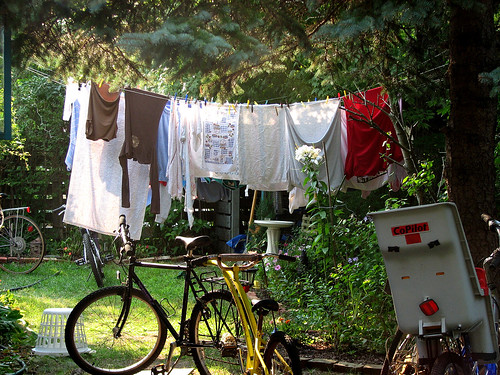Ever give much thought to your food scraps? All those potato peelings, bits of onion or excess from a head of cabbage? Most people just scrape the food off into the trash can or flip the switch and the disposal grinds it all up. Now is the first time in nearly 20 years that I’ve had a garbage disposal, all my post-parents places have lacked a disposal. With the exception of six months living in an 8th floor studio apartment on Lindell, I’ve had a yard for these past two decades. And in having a yard, I managed to compost nearly all my food waste — be that scraps from preparing a meal to the usual table scraps.
Now I am back in an urban setting in a multi-family building lacking a yard to compost in. Composting is great, allowing earth’s worms to come up and help out the process of breaking down matter. So what do you do in a situation where you lack the yard and earth worms? Well, you bring the worms into the home for a process known as vermicomposting. But before I get into looking at the process I plan to undertake, let’s look at the environmental implications to more conventional disposal methods — the garbage disposal to grind and send it all to the sewage treatment plant and just dumping it in the garbage for shipment off to a land fill.
The disposal is about as convenient as they come, using it to rid ourselves of meal prep scraps as well as those un-eaten bits post-dinner. Dump, turn on the water and flip the switch. Like magic it is gone. Ever think about where it goes?
The ground-up waste does NOT go back to nature’s water supply to be gobbled up by fish and other life forms. It must first pass through the sewage-treatment plant (or your septic system). This not only increases the load on our already overburdened sewage-treatment facilities, the process also removes any food value the waste might have had further down the line. (source: Grinning Planet)
So food that might help out your own garden is flushed into the sewer system, our very old and fragile sewer system, that MSD is spending Billions (yes, Billions with a B) to upgrade. MSD covers all of the city and the bulk of St. Louis County. Other parts of our 16-county region are covered under other sewer systems or are on septic. While I couldn’t find what to flush and not flush on MSD’s website I did see in other cities them asking that you not use your disposal, that food waste be placed in the trash. Which brings us to land fills.
Have you seen the massive pile of trash over in Illinois? In the news lately has been the proposed trash transfer center in South County that the Fred Weber company wants to build. Fred Weber wants to take their old quarry site to bring in trash trucks so the trash can be collected and then loaded onto larger trucks for removal. Neighbors are understandably upset. However, I wonder how many of those that are so upset bother to recycle their trash? Or to look for items with reduced packaging? Their objections would have more impact if they didn’t help contribute to the problem of trash collection and removal to a landfill.
Oh yeah, the landfill. I’ve read that responsible landfills are supposed to allow food waste to decompose but I can’t imagine how — locked up tight in the hefty bag with all the other garbage it doesn’t get any air. The reality is that what we throw away stays in a landfill basically forever. Where, we don’t exactly know. Sadly, most really don’t care.
The only green alternative for food waste is backyard composting. Layer by layer you are slowly building a wonderful fertilizer to use in your vegetable or flower garden. But say you are like me, now lacking a yard, you are not out of luck. Why? Worms can be house broken. In a well-prepared plastic or wood container in the home they can eat through your garbage — it is what they do.
Today I purchased a $5 container at Family Dollar, I’ve shredded up old paper used to pack dishes and I’m ready to start drilling holes for air circulation (proper air circulation eliminates odor you might get otherwise). I’m not going to attempt to explain the ins and outs of vermicomposting to you — I’ll leave that to the experts. Here is a fun “how to” video with a master composter:
[Note: embedded video seemed to only work well on the Mac so I have deleted it. Use the link provided to watch the video.]
This video can be found here. Barb can also be seen in two Freshtopia videos located here and here. You can get more information on vermicomposting at Wiki. The Fed’s even support the idea with their own page on the EPA website! I’ll keep you posted on the progress and any issues I may encounter along the way.
Next time you toss out the core of that organic apple that you bought at Whole Foods, after driving there in your Prius hybrid, think about how green your lifestyle really is and if you can go further.
UPDATE 11/29/07 @ 8:20pm — Ryanne and Jay managed to kill their worms after five months. Check out updates here and here. I’ve yet to start my bin yet but I am very close — still researching just the right container.



